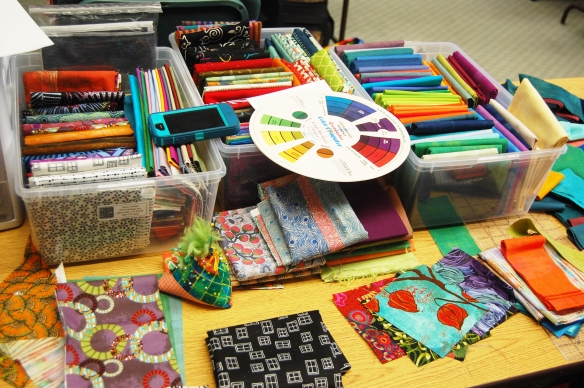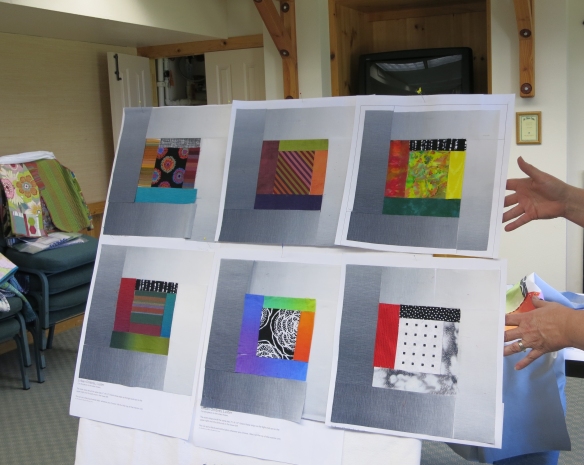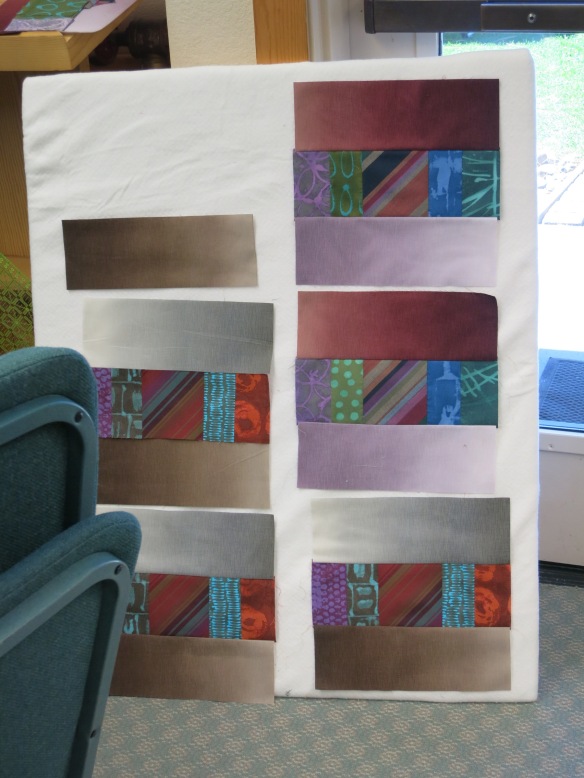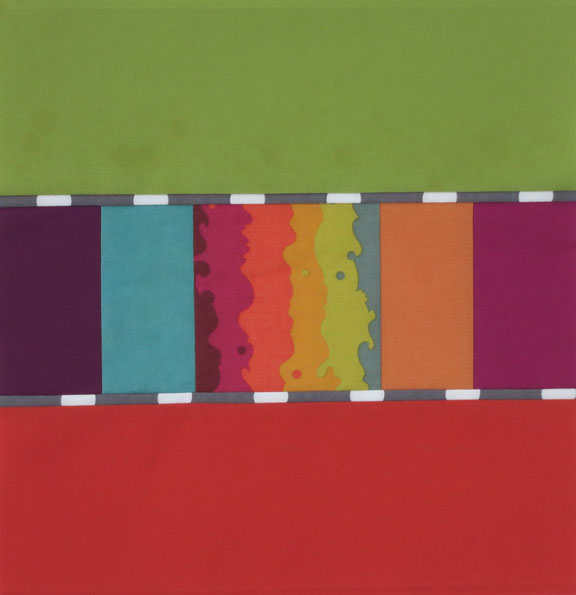by Christine Barnes
 The past month has been a whirlwind of travel, but gosh, it has been FUN. I’m calling it my California Coastal Color Tour because I taught a different workshop for guilds in San Diego, Arroyo Grande, and Santa Cruz. For this post I’d like to show you what twenty diligent (and cheerfully rowdy) Santa Cruz students did with my “Transparent Circles” pattern. The original quilt, made of shot cottons and Marcia Derse prints:
The past month has been a whirlwind of travel, but gosh, it has been FUN. I’m calling it my California Coastal Color Tour because I taught a different workshop for guilds in San Diego, Arroyo Grande, and Santa Cruz. For this post I’d like to show you what twenty diligent (and cheerfully rowdy) Santa Cruz students did with my “Transparent Circles” pattern. The original quilt, made of shot cottons and Marcia Derse prints: I refer to this kind of transparency as “layered,” which is different from parent/child transparency. Here’s an overview of how I make the blocks, using the upper left block in the quilt as an example.
I refer to this kind of transparency as “layered,” which is different from parent/child transparency. Here’s an overview of how I make the blocks, using the upper left block in the quilt as an example.
I piece four smaller squares of light fabrics and four larger squares of corresponding dark fabrics. Using the template below, I cut out a freezer-paper circle (double layer, for stability) and mark each quarter line with a small slit. I then trim the light unit of squares a scant ¼ inch beyond the freezer-paper circle and press the raw edge over and onto the shiny side of the paper. Finally, I appliqué the circle to the larger pieced unit, lining up the seams, and cut away and remove the paper from the back. You make “in and out” blocks, using the same eight fabrics. I love seeing how different the block looks with the light and dark fabrics reversed.
You make “in and out” blocks, using the same eight fabrics. I love seeing how different the block looks with the light and dark fabrics reversed. 
Circles in progress . . . . Brenda’s blocks, with help from Lori. Notice that the colors are in the same location in each block. So cool!
Brenda’s blocks, with help from Lori. Notice that the colors are in the same location in each block. So cool! What fun to see some of the different blocks. Happy students, successful circles. That’s my traveling buddy Kari toward the back.
What fun to see some of the different blocks. Happy students, successful circles. That’s my traveling buddy Kari toward the back. Meryl (my facilitator for the trip—thank you so much) with her first block. The dark green and orange Grunge fabrics give the block a lovely texture.
Meryl (my facilitator for the trip—thank you so much) with her first block. The dark green and orange Grunge fabrics give the block a lovely texture. 
Could there be a cuter picture? Pat, my hostess (we loved staying with you!) and her blocks made of Gelato ombrés. She’s the first to try Gelatos for these blocks, and I think they are awesome.
The next day we had breakfast at the home of a local wearable artist. I way taken by the arrangement and color of these elements in her courtyard. Pat and Lori then took us to Back Porch Fabrics in Pacific Grove, a wonderful, must-visit shop on the corner of Grand and Central streets. Who can forget that location?
Pat and Lori then took us to Back Porch Fabrics in Pacific Grove, a wonderful, must-visit shop on the corner of Grand and Central streets. Who can forget that location? We were in for one more treat the morning we left, Gayle’s bakery, a Santa Cruz landmark and a feast for the eyes and the palette. If you aren’t hungry when you go, you will be when you look at the array of pastries and goodies!
We were in for one more treat the morning we left, Gayle’s bakery, a Santa Cruz landmark and a feast for the eyes and the palette. If you aren’t hungry when you go, you will be when you look at the array of pastries and goodies! Owner Gayle Ortiz did the picassiette (broken pottery mosaic) on some of the tables, as well as one wall.
Owner Gayle Ortiz did the picassiette (broken pottery mosaic) on some of the tables, as well as one wall.
I don’t know about you, but I see a fabric design in this . . . . We headed home, with new memories, friends, and fabrics. And as often happens after I teach a class, I want to make the quilt again, this time with Grunges and Peppered Cottons. Thanks so much for tuning in this week. For my next post I’ll have tales to tell from another coast—the coast of Florida!
We headed home, with new memories, friends, and fabrics. And as often happens after I teach a class, I want to make the quilt again, this time with Grunges and Peppered Cottons. Thanks so much for tuning in this week. For my next post I’ll have tales to tell from another coast—the coast of Florida!















































